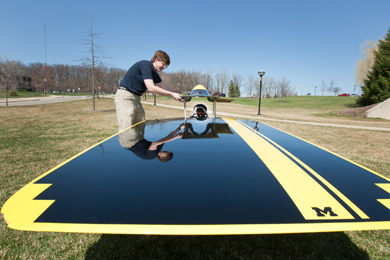- Date
- April 13, 2011
- Written By
-
Nicole Casal Moore

With its sleek 2011 car Quantum now built and ready for testing, U-M’s No. 1 solar car team in America is preparing to take on the world.http://www.youtube.com/watch?v=zhGDDNIfUF8The reigning champions of the North American Solar Challenge will compete in the 1,800-mile World Solar Challenge across the Australian outback in October. The U-M team, which has been around for two decades, has won the continental race six times and finished third in the global contest four times.This year they’re shooting for best in the world.”I think we have a better chance of winning this year than we’ve ever had in the past,” says Chris Hilger, the team’s business manager who is a junior in chemical engineering. “We have collaborated with the university and industry at an unprecedented level to give our team access to the best engineering talent and resources the automotive industry has to offer.”

University of Michigan solar car team interim operations director Aaron Frantz, a sophomore mechanical engineering student, helps load driver Santosh Kumar into the 2011 solar car Quantum. Kumar, a master’s student in aerospace engineering, is the team’s engineering director. (Photo: Scott Soderberg, U-M Photo Services.)
Quantum is a cutting edge electric vehicle with an aerodynamic and light carbon fiber body, a high-performance battery and energy-efficient regenerative braking.The students, who build a new vehicle every two years, completely streamlined the car this time. They took apart the 2009-10 vehicle Infinium—one of the team’s heaviest at 500 pounds—and weighed every part, down to the nuts and bolts.”We’ve been monitoring the weight in a way that we haven’t done in a long time, or perhaps never have,” says Rachel Kramer, the team’s project manager who is a junior neuroscience student. “Solar power doesn’t produce much energy, so we’re building the most efficient car we can.”The team for the first time used advanced modeling software to determine the true forces the car and its components experience on the highway.”It turns out we were building the car to respond to more force than the car was actually experiencing and now that we know that, we can make lighter parts,” Kramer says.The team has done all this on a tighter timeline. The students finished the car months earlier than they usually do so the team can compete in the Formula Sun Grand Prix in early May. This will allow them more time for testing and practicing.New race regulations also are expected to even out the playing field, Hilger says. Teams that can afford the more expensive but better performing gallium arsenide solar cells are allowed only three square meters of them. Teams using silicon cells can use twice that.With more than 100 students from schools and colleges across the university, the Solar Car Team is one of the largest student organizations on campus.





Scott Sbihli - 1994
I was part of the team and race crew from the first team in 1990. Great to see that this is alive and well. Best of luck winning the US and Australian races.
Reply